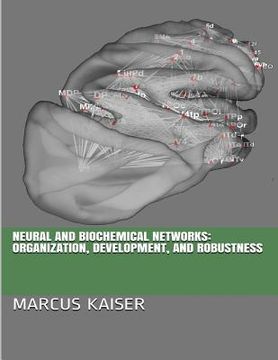Compartir
Neural and Biochemical Networks: Organization, Development, and Robustness (en Inglés)
Marcus Kaiser
(Autor)
·
Createspace Independent Publishing Platform
· Tapa Blanda
Neural and Biochemical Networks: Organization, Development, and Robustness (en Inglés) - Kaiser, Marcus
$ 134.915
$ 269.831
Ahorras: $ 134.915
Elige la lista en la que quieres agregar tu producto o crea una nueva lista
✓ Producto agregado correctamente a la lista de deseos.
Ir a Mis Listas
Origen: Estados Unidos
(Costos de importación incluídos en el precio)
Se enviará desde nuestra bodega entre el
Lunes 22 de Julio y el
Miércoles 31 de Julio.
Lo recibirás en cualquier lugar de Colombia entre 1 y 5 días hábiles luego del envío.
Reseña del libro "Neural and Biochemical Networks: Organization, Development, and Robustness (en Inglés)"
During the last decades great progress has been made in understanding the structure and function of single nerve cells. However, little is known about the global organization of connections between cortical areas and how this structural cortical network relates to function as measured by functional imaging or electro-encephalograms (EEG). In this work, I therefore studied the organization, development and robustness of cortical, as well as other biological networks, using methods of network analysis. Chapter 1 gives a brief introduction to networks in biology and outlines previous concepts as well as novel approaches of network analysis. Chapter 2 presents the data sources for biological as well as non-biological networks used in this study. In addition, limitations of the available data and validity of results based on incomplete data sets are discussed. Chapter 3 examines the organization of neural systems and important constraints for shaping them. The spatial network of macaque cortical connections shows surprisingly many long-distance connections. In addition, area positions in the macaque cortical as well as the C. elegans neural networks could be rearranged so that total wiring length can be reduced by up to 64 of the original value. I show that despite their high resource consumption, long-distance connections help to minimize the number of intermediate nodes, which leads to lower time delay, less interference, and higher synchrony in the network. Chapter 4 deals with the growth of networks in space. I designed a developmental algorithm that takes into account distance between nodes and which yields networks that are alike various spatial networks from metabolic networks to the German highway system. Such spatial growth can generate networks that are comparable to cat and macaque cortical networks both in respect to neighborhood clustering, number of intermediate nodes and total wiring length. In addition, the inclusion of time windows for development can lead to a defined cluster architecture as observed for cortical networks. Chapter 5 analyzes the measurement of robustness in biological networks as well as possible underlying causes for high robustness towards unspecific removal of edges or nodes. Biological networks are remarkably robust and I tested different measures to predict the effect of removing edges from the networks. In addition, cortical networks show similar behavior after removal of network components as scale-free networks. The existence of clusters and of highly-connected nodes results in enhanced average-case robustness after removal of edges or nodes. Using multiple lesions, I found that in some cases the effect differed from the effect that was predicted from single lesions. Therefore, multiple lesion analysis could become a framework to predict or explain 'unexpected' effects of experimental lesions (or multiple gene knock-outs in metabolic systems). Chapter 6 presents a general discussion as well as an outlook on future research including possible technical applications of the current results. As the approach of network analysis is relatively new to the neurosciences, a glossary of key terms is also provided. [This book is a PhD thesis submitted in July 2005]

